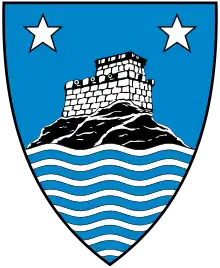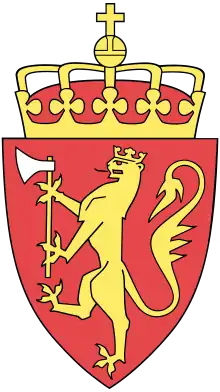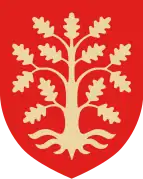Risør
![]() Risør is a municipality in Agder county, Norway. It is located along the Skagerrak coast in the traditional region of Sørlandet. The administrative centre of Risør is the town of Risør. There are many villages in Risør such as Akland, Bossvika, Fie, Hødnebø, Krabbesund, Moen, Nipe, Røysland, Sandnes, Sivik, Søndeled, and Stamsø.
Risør is a municipality in Agder county, Norway. It is located along the Skagerrak coast in the traditional region of Sørlandet. The administrative centre of Risør is the town of Risør. There are many villages in Risør such as Akland, Bossvika, Fie, Hødnebø, Krabbesund, Moen, Nipe, Røysland, Sandnes, Sivik, Søndeled, and Stamsø.
Risør kommune | |
|---|---|
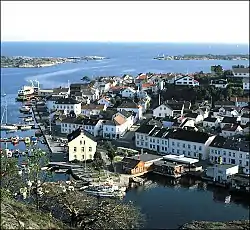 View of the town of Risør | |
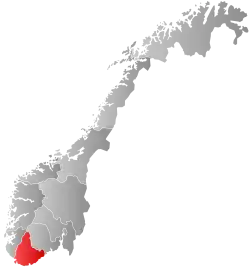 Agder within Norway | |
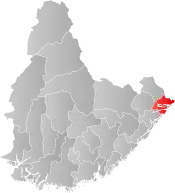 Risør within Agder | |
| Coordinates: 58°43′35″N 09°11′40″E | |
| Country | Norway |
| County | Agder |
| District | Østre Agder |
| Established | 1 Jan 1838 |
| Administrative centre | Risør |
| Government | |
| • Mayor (2011) | Per Kristian Lunden (Ap) |
| Area | |
| • Total | 192.97 km2 (74.51 sq mi) |
| • Land | 179.02 km2 (69.12 sq mi) |
| • Water | 13.95 km2 (5.39 sq mi) 7.2% |
| Area rank | 302 in Norway |
| Population (2020) | |
| • Total | 6,809 |
| • Rank | 102 in Norway |
| • Density | 38/km2 (100/sq mi) |
| • Change (10 years) | −1.2% |
| Demonym(s) | Risøring[1] |
| Time zone | UTC+01:00 (CET) |
| • Summer (DST) | UTC+02:00 (CEST) |
| ISO 3166 code | NO-4201 |
| Official language form | Neutral[2] |
| Website | risor |
Risør is a tourist destination, and the surrounding area includes many small lakes and hills. Together with its coastline, Risør is known for its tourist attractions such as the wooden boat festival which is staged during the first week of August every year. It also has a growing reputation as the regional capital of arts and crafts, which culminates in the "Villvin-festival" during the summer holiday.[3]
The 193-square-kilometre (75 sq mi) municipality is the 302nd largest by area out of the 356 municipalities in Norway. Risør is the 145th most populous municipality in Norway with a population of 6,809. The municipality's population density is 38 inhabitants per square kilometre (98/sq mi) and its population has decreased by 1.2% over the previous 10-year period.[4][5]
General information
.jpg.webp)
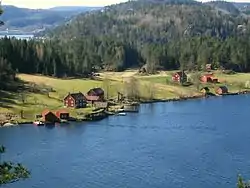
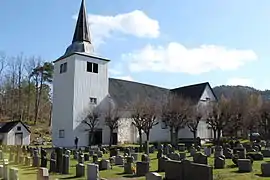
The town of Risør was established as a municipality on 1 January 1838 (see formannskapsdistrikt law). On 1 January 1901, a part of the neighboring Søndeled municipality (population: 658) was transferred to Risør. During the 1960s, there were many municipal mergers across Norway due to the work of the Schei Committee. On 1 January 1964, the rural municipality of Søndeled (population: 3,134) was merged into the town of Risør (population: 3,002) to form a new municipality of Risør which had a population of 6,136. On 1 January 1984, the uninhabited Folevatnet area of neighboring Tvedestrand was transferred to Risør.[6]
Name
The name for the town (and municipality) of Risør likely comes from the Old Norse name Ríseyjar. The first element is rís which means "thicket" and the last element is eyjar which is the plural form of "island". The relatively more modern Danish version of eyjar is øer, hence the current spelling of Risør. The name was originally referring to the nearby island of Risøya which is located just outside the town. The old name of the town (prior to 1909) was Øster Riisöer or Østerrisør (meaning "eastern Risør"). After 1909, it was simply called Risør. The first element was added in the 16th century to distinguish the town from Vesterrisør, the old name of Mandal.[3]
Coat of arms
The coat of arms was granted on 18 July 1891. The blue, black, and white arms show a lighthouse on a rocky island surrounded by water. There are two white stars in the top corners of the arms. The lighthouse was chosen to symbolize the Holmen fortress built in 1788. The history of these arms is quite curious. It is said that on 18 July 1891 King Oscar II visited the town of Risør so a menu had to be printed. It was printed with a coat of arms on the top, which was probably designed by the printer. That afternoon the King approved the new arms, mainly because his name was printed under the arms on the menu.[7]
Churches
The Church of Norway has two parishes (sokn) within the municipality of Risør. It is part of the Aust-Nedenes prosti (deanery) in the Diocese of Agder og Telemark.
| Parish (sokn) | Church name | Location of the church | Year built |
|---|---|---|---|
| Risør | Frydendal Church | Risør | 1879 |
| Risør Church | Risør | 1647 | |
| Søndeled | Søndeled Church | Søndeled | c. 1150 |
Politics
In the 2007 municipal elections, Risør had the highest vote for the Red Electoral Alliance in Norway at 13.7 per cent. Also, Knut Henning Thygesen was elected as the only mayor from the Red Party through a direct mayor election.[8]
History
.jpg.webp)
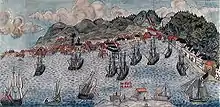
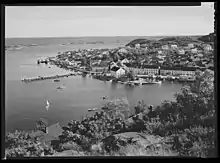
The village of Risør was a small fishing village in the prestegjeld of Søndeled when Dutch vessels began to call there to purchase timber around the year 1570. By 1607, two inns had been opened to serve Dutch sailors. In 1630, Risør became a privileged port (ladested). The town has a timber church, Risør Church which was built in the Baroque style in 1647.
In 1723, Risør was granted town status which granted it a number of commercial privileges. By the end of the 18th century, 96 sailing vessels were owned by Risør merchants. It was the sixth largest shipping town and one of four shipbuilding centers in Norway.
In Letters on Sweden, Norway, and Denmark, Mary Wollstonecraft wrote extensively while visiting Risør in 1783, including the following remarks:[9]
- On entering Risør: "We were a considerable time entering amongst the islands, before we saw about two hundred houses crowded together under a very high rock—still higher appearing above."
- While at Risør: "...seaports are not favorable to improvement. The captains acquire a little superficial knowledge by traveling, which their indefatigable attention to the making of money prevents their digesting; and the fortune that they thus laboriously acquire is spent, as it usually is in towns of this description, in show and good living."
- While departing Risør: "The view of the town was now extremely fine. A huge rocky mountain stood up behind it, and a vast cliff stretched on each side, forming a semicircle. In a recess of the rocks was a clump of pines, amongst which a steeple rose picturesquely beautiful."
Risør played a role in the Napoleonic Wars in 1807–1814, when Denmark–Norway took France's side, and therefore became the enemy of Norway's most important trading-partner: Great Britain. (It is from this period that Henrik Ibsen took his subject, when he created his famous poem Terje Vigen.) It was south of Risør, in Lyngør (now in the neighboring Tvedestrand municipality) that several British warships, headed by HMS Dictator of the English navy pursued and sank the last major vessel and the pride of Norway: the frigate HDMS Najaden.
On 1 January 1838, the new formannskapsdistrikt law came into effect, granting each parish and town in Norway the rights to have a self-governing council. Thus, Risør was a small town with a council to run it.[6]
Risør was almost wiped off the map in 1861. A great fire swept across the small town leaving just 85 houses and the 1647 Risør Church. The entire road network was re-worked after the fire to remove the small streets and alleys and have wider roads that are there today. The city was redesigned and rebuilt and today it presents a positive impression of a well kept town with white, wooden houses. White was chosen because it was an expensive paint and the residents wanted to give an expression of prosperity. Still today, most houses have white paint, although some have other colors on the sides and back of their houses.
By the second half of the 19th century, over 100 sailing vessels were based at their home port in Risør and more than 1,000 sailors called Risør home. The transition to steamships and the economic damage of World War I, however, destroyed Risør's shipping industry.
On 1 January 1901, an area of the neighboring municipality of Søndeled (population: 658) was transferred to the city, greatly expanding Risør. During the 1960s, there were many municipal mergers across Norway due to the work of the Schei Committee. On 1 January 1964, the town of Risør (population: 3,002) and the entire municipality of Søndeled (population: 3,134) were merged to form a new, much larger municipality of Risør, with the town being the administrative centre.[6]
Geography
Risør is the easternmost coastal municipality in Agder county, located on the peninsula between the mouths of the Søndeledfjorden and Sandnesfjorden, providing ready access to the Skagerrak. Risør municipality is bordered to the southwest by Tvedestrand, to the northwest by Vegårshei and Gjerstad, and to the northeast by Kragerø in Vestfold og Telemark county. The Nordfjorden is a branch of the Søndeledfjorden that flows to the north of the large island of Barmen.[10][11]
Government
All municipalities in Norway, including Risør, are responsible for primary education (through 10th grade), outpatient health services, senior-citizen services, unemployment and other social services, zoning, economic development, and municipal roads. The municipality is governed by a municipal council of elected representatives, which in turn elect a mayor.[12] The municipality falls under the Aust-Agder District Court and the Agder Court of Appeal.
Municipal council
The municipal council (Kommunestyre) of Risør is made up of 29 representatives that are elected to four-year terms. Currently, the party breakdown is as follows:
| Party Name (in Norwegian) | Number of representatives | |
|---|---|---|
| Labour Party (Arbeiderpartiet) | 9 | |
| Progress Party (Fremskrittspartiet) | 2 | |
| Conservative Party (Høyre) | 9 | |
| Christian Democratic Party (Kristelig Folkeparti) | 1 | |
| Red Party (Rødt) | 3 | |
| Centre Party (Senterpartiet) | 2 | |
| Liberal Party (Venstre) | 3 | |
| Total number of members: | 29 | |
| Party Name (in Norwegian) | Number of representatives | |
|---|---|---|
| Labour Party (Arbeiderpartiet) | 13 | |
| Progress Party (Fremskrittspartiet) | 2 | |
| Green Party (Miljøpartiet De Grønne) | 1 | |
| Conservative Party (Høyre) | 5 | |
| Christian Democratic Party (Kristelig Folkeparti) | 2 | |
| Centre Party (Senterpartiet) | 1 | |
| Liberal Party (Venstre) | 5 | |
| Total number of members: | 29 | |
| Party Name (in Norwegian) | Number of representatives | |
|---|---|---|
| Labour Party (Arbeiderpartiet) | 11 | |
| Progress Party (Fremskrittspartiet) | 2 | |
| Conservative Party (Høyre) | 5 | |
| Christian Democratic Party (Kristelig Folkeparti) | 2 | |
| Red Party (Rødt) | 4 | |
| Centre Party (Senterpartiet) | 1 | |
| Liberal Party (Venstre) | 4 | |
| Total number of members: | 29 | |
| Party Name (in Norwegian) | Number of representatives | |
|---|---|---|
| Labour Party (Arbeiderpartiet) | 8 | |
| Progress Party (Fremskrittspartiet) | 4 | |
| Conservative Party (Høyre) | 6 | |
| Christian Democratic Party (Kristelig Folkeparti) | 3 | |
| Pensioners' Party (Pensjonistpartiet) | 1 | |
| Red Electoral Alliance (Rød Valgallianse) | 4 | |
| Centre Party (Senterpartiet) | 1 | |
| Liberal Party (Venstre) | 4 | |
| Total number of members: | 31 | |
| Party Name (in Norwegian) | Number of representatives | |
|---|---|---|
| Labour Party (Arbeiderpartiet) | 7 | |
| Progress Party (Fremskrittspartiet) | 2 | |
| Conservative Party (Høyre) | 7 | |
| Christian Democratic Party (Kristelig Folkeparti) | 3 | |
| Red Electoral Alliance (Rød Valgallianse) | 3 | |
| Centre Party (Senterpartiet) | 5 | |
| Socialist Left Party (Sosialistisk Venstreparti) | 2 | |
| Liberal Party (Venstre) | 2 | |
| Total number of members: | 31 | |
| Party Name (in Norwegian) | Number of representatives | |
|---|---|---|
| Labour Party (Arbeiderpartiet) | 8 | |
| Progress Party (Fremskrittspartiet) | 2 | |
| Conservative Party (Høyre) | 4 | |
| Christian Democratic Party (Kristelig Folkeparti) | 4 | |
| Red Electoral Alliance (Rød Valgallianse) | 3 | |
| Centre Party (Senterpartiet) | 8 | |
| Liberal Party (Venstre) | 2 | |
| Total number of members: | 31 | |
| Party Name (in Norwegian) | Number of representatives | |
|---|---|---|
| Labour Party (Arbeiderpartiet) | 10 | |
| Progress Party (Fremskrittspartiet) | 2 | |
| Conservative Party (Høyre) | 7 | |
| Christian Democratic Party (Kristelig Folkeparti) | 3 | |
| Red Electoral Alliance (Rød Valgallianse) | 2 | |
| Centre Party (Senterpartiet) | 4 | |
| Liberal Party (Venstre) | 3 | |
| Total number of members: | 31 | |
| Party Name (in Norwegian) | Number of representatives | |
|---|---|---|
| Labour Party (Arbeiderpartiet) | 12 | |
| Progress Party (Fremskrittspartiet) | 2 | |
| Conservative Party (Høyre) | 5 | |
| Christian Democratic Party (Kristelig Folkeparti) | 4 | |
| Red Electoral Alliance (Rød Valgallianse) | 1 | |
| Centre Party (Senterpartiet) | 3 | |
| Socialist Left Party (Sosialistisk Venstreparti) | 2 | |
| Liberal Party (Venstre) | 2 | |
| Total number of members: | 31 | |
| Party Name (in Norwegian) | Number of representatives | |
|---|---|---|
| Labour Party (Arbeiderpartiet) | 10 | |
| Progress Party (Fremskrittspartiet) | 4 | |
| Conservative Party (Høyre) | 7 | |
| Christian Democratic Party (Kristelig Folkeparti) | 4 | |
| Red Electoral Alliance (Rød Valgallianse) | 1 | |
| Centre Party (Senterpartiet) | 1 | |
| Socialist Left Party (Sosialistisk Venstreparti) | 1 | |
| Liberal Party (Venstre) | 3 | |
| Total number of members: | 31 | |
| Party Name (in Norwegian) | Number of representatives | |
|---|---|---|
| Labour Party (Arbeiderpartiet) | 12 | |
| Progress Party (Fremskrittspartiet) | 2 | |
| Conservative Party (Høyre) | 7 | |
| Christian Democratic Party (Kristelig Folkeparti) | 5 | |
| Centre Party (Senterpartiet) | 1 | |
| Socialist Left Party (Sosialistisk Venstreparti) | 1 | |
| Liberal Party (Venstre) | 3 | |
| Total number of members: | 31 | |
| Party Name (in Norwegian) | Number of representatives | |
|---|---|---|
| Labour Party (Arbeiderpartiet) | 10 | |
| Conservative Party (Høyre) | 7 | |
| Christian Democratic Party (Kristelig Folkeparti) | 5 | |
| Centre Party (Senterpartiet) | 1 | |
| Socialist Left Party (Sosialistisk Venstreparti) | 1 | |
| Liberal Party (Venstre) | 4 | |
| Cross-party list (Tverrpolitisk liste) | 3 | |
| Total number of members: | 31 | |
| Party Name (in Norwegian) | Number of representatives | |
|---|---|---|
| Labour Party (Arbeiderpartiet) | 9 | |
| Conservative Party (Høyre) | 5 | |
| Christian Democratic Party (Kristelig Folkeparti) | 5 | |
| New People's Party (Nye Folkepartiet) | 2 | |
| Centre Party (Senterpartiet) | 1 | |
| Liberal Party (Venstre) | 1 | |
| Cross-party local list (Tverrpolitisk Bygdeliste) | 8 | |
| Total number of members: | 31 | |
| Party Name (in Norwegian) | Number of representatives | |
|---|---|---|
| Labour Party (Arbeiderpartiet) | 12 | |
| Conservative Party (Høyre) | 5 | |
| Christian Democratic Party (Kristelig Folkeparti) | 5 | |
| Centre Party (Senterpartiet) | 2 | |
| Socialist People's Party (Sosialistisk Folkeparti) | 1 | |
| Liberal Party (Venstre) | 6 | |
| Total number of members: | 31 | |
| Party Name (in Norwegian) | Number of representatives | |
|---|---|---|
| Labour Party (Arbeiderpartiet) | 14 | |
| Conservative Party (Høyre) | 5 | |
| Christian Democratic Party (Kristelig Folkeparti) | 5 | |
| Centre Party (Senterpartiet) | 1 | |
| Liberal Party (Venstre) | 6 | |
| Total number of members: | 31 | |
| Party Name (in Norwegian) | Number of representatives | |
|---|---|---|
| Labour Party (Arbeiderpartiet) | 14 | |
| Conservative Party (Høyre) | 5 | |
| Christian Democratic Party (Kristelig Folkeparti) | 4 | |
| Centre Party (Senterpartiet) | 1 | |
| Liberal Party (Venstre) | 7 | |
| Total number of members: | 31 | |
| Party Name (in Norwegian) | Number of representatives | |
|---|---|---|
| Labour Party (Arbeiderpartiet) | 10 | |
| Conservative Party (Høyre) | 5 | |
| Liberal Party (Venstre) | 6 | |
| Total number of members: | 21 | |
| Party Name (in Norwegian) | Number of representatives | |
|---|---|---|
| Labour Party (Arbeiderpartiet) | 10 | |
| Conservative Party (Høyre) | 4 | |
| Liberal Party (Venstre) | 4 | |
| Joint List(s) of Non-Socialist Parties (Borgerlige Felleslister) | 3 | |
| Total number of members: | 21 | |
| Party Name (in Norwegian) | Number of representatives | |
|---|---|---|
| Labour Party (Arbeiderpartiet) | 10 | |
| Conservative Party (Høyre) | 4 | |
| Liberal Party (Venstre) | 3 | |
| Joint List(s) of Non-Socialist Parties (Borgerlige Felleslister) | 3 | |
| Total number of members: | 20 | |
| Party Name (in Norwegian) | Number of representatives | |
|---|---|---|
| Labour Party (Arbeiderpartiet) | 9 | |
| Conservative Party (Høyre) | 4 | |
| Christian Democratic Party (Kristelig Folkeparti) | 3 | |
| Joint list of the Liberal Party (Venstre) and the Radical People's Party (Radikale Folkepartiet) | 4 | |
| Total number of members: | 20 | |
| Party Name (in Norwegian) | Number of representatives | |
|---|---|---|
| Labour Party (Arbeiderpartiet) | 12 | |
| Conservative Party (Høyre) | 3 | |
| Communist Party (Kommunistiske Parti) | 1 | |
| Joint list of the Liberal Party (Venstre) and the Radical People's Party (Radikale Folkepartiet) | 3 | |
| Local List(s) (Lokale lister) | 9 | |
| Total number of members: | 28 | |
| Party Name (in Norwegian) | Number of representatives | |
|---|---|---|
| Labour Party (Arbeiderpartiet) | 11 | |
| Temperance Party (Avholdspartiet) | 4 | |
| Liberal Party (Venstre) | 5 | |
| Joint list of the Conservative Party (Høyre) and the Free-minded People's Party (Frisinnede Folkeparti) | 8 | |
| Total number of members: | 28 | |
| Party Name (in Norwegian) | Number of representatives | |
|---|---|---|
| Labour Party (Arbeiderpartiet) | 9 | |
| Temperance Party (Avholdspartiet) | 5 | |
| Free-minded People's Party (Frisinnede Folkeparti) | 4 | |
| Conservative Party (Høyre) | 5 | |
| Liberal Party (Venstre) | 5 | |
| Total number of members: | 28 | |
| Party Name (in Norwegian) | Number of representatives | |
|---|---|---|
| Labour Party (Arbeiderpartiet) | 8 | |
| Temperance Party (Avholdspartiet) | 5 | |
| Free-minded People's Party (Frisinnede Folkeparti) | 4 | |
| Conservative Party (Høyre) | 5 | |
| Liberal Party (Venstre) | 6 | |
| Total number of members: | 28 | |
| Party Name (in Norwegian) | Number of representatives | |
|---|---|---|
| Labour Party (Arbeiderpartiet) | 9 | |
| Temperance Party (Avholdspartiet) | 6 | |
| Free-minded Liberal Party (Frisinnede Venstre) | 4 | |
| Conservative Party (Høyre) | 5 | |
| Liberal Party (Venstre) | 4 | |
| Total number of members: | 28 | |
| Party Name (in Norwegian) | Number of representatives | |
|---|---|---|
| Labour Party (Arbeiderpartiet) | 6 | |
| Temperance Party (Avholdspartiet) | 6 | |
| Liberal Party (Venstre) | 7 | |
| Joint list of the Conservative Party (Høyre) and the Free-minded Liberal Party (Frisinnede Venstre) | 9 | |
| Total number of members: | 28 | |
| Party Name (in Norwegian) | Number of representatives | |
|---|---|---|
| Labour Party (Arbeiderpartiet) | 5 | |
| Temperance Party (Avholdspartiet) | 7 | |
| Liberal Party (Venstre) | 6 | |
| Joint list of the Conservative Party (Høyre) and the Free-minded Liberal Party (Frisinnede Venstre) | 9 | |
| Local List(s) (Lokale lister) | 1 | |
| Total number of members: | 28 | |
| Party Name (in Norwegian) | Number of representatives | |
|---|---|---|
| Labour Party (Arbeiderpartiet) | 5 | |
| Temperance Party (Avholdspartiet) | 5 | |
| Liberal Party (Venstre) | 9 | |
| Joint list of the Conservative Party (Høyre) and the Free-minded Liberal Party (Frisinnede Venstre) | 9 | |
| Total number of members: | 28 | |
Transportation
Risør is located along the Skaggerak coast. The Stangholmen Lighthouse sits just offshore, marking a shipping channel leading to the town harbour. The European route E18 highway runs along the western edge of the municipality. The Norwegian County Road 416 connects the E18 highway with the town centre in the eastern side of the municipality. Other main roads in Risør include Norwegian County Road 411 and Norwegian County Road 418.
Economy
Risør was a town built as a result of shipping and industrial interests. The historic timber and fishing industries thrived for a few hundred years, but now they have mostly vanished. Paper production served as an economic basis for a time, until the pulp factory was closed in 1970. Today Risør is more of a tourist destination with a burgeoning art colony and music festivals. Summer vacationers account for a major part of the economy.[3]
Attractions
Risør has many tourist attractions.[37][38][39]
- A world class chamber music festival, is held in late June
- A bluegrass music-festival every mid-July. Norway's only festival of its kind.
- A popular artists’ market (Villvinmarked or "Villvin-festival") is held in July
- A wooden boat festival (Trebåtfestival) is held in August. During the festival the population swells to 20,000 people.[40]
- Den Hellige Ånds Church, built in 1647
- The citadel at Tangen, a fortification from the Napoleonic Wars (with modifications from the German occupation period)
- Risør Akvarium, salt water aquarium with over 100 different species. The only salt water aquarium in the south region of Norway.
Notable residents


- Isak Lauritssøn Falck (1601–1669), a land owner and timber merchant, developed Risør [41]
- Christian Jensen Lofthuus (1750-1797) led a peasant revolt in 1786 called Lofthusreisingen
- Henrik Carstensen (1753–1835) timber merchant, shipowner, rep. Norwegian Constituent Assembly
- Carsten Henrik Bruun (1828–1907) shipmaster of whaling vessels, also involved in sealing
- Nikolai Prebensen (1850–1938) politician and County Governor of Finnmark & Aust-Agder
- Dikken Zwilgmeyer (1853–1913) a Norwegian fiction writer of children's literature
- Isak Martinius Skaugen (1875–1962) a sea captain, founded I. M. Skaugen a shipping co.
- Ove Ansteinsson (1884–1942), a journalist and author
- Per Sunderland (1924–2012) a Norwegian stage and film actor [42]
- Victor D. Norman (born 1946) politician & professor of economy and rector at NHH
- Carl Magnus Neumann (born 1944) jazz saxophonist, lived in Risør since 20000
- Knut Henning Thygesen (born 1953) author and politician, Mayor of Risør from 2007
- Erik Mykland (born 1971) a footballer with 371 club caps and 78 for Norway
References
- "Navn på steder og personer: Innbyggjarnamn" (in Norwegian). Språkrådet.
- "Forskrift om målvedtak i kommunar og fylkeskommunar" (in Norwegian). Lovdata.no.
- Thorsnæs, Geir, ed. (5 April 2016). "Risør". Store norske leksikon (in Norwegian). Kunnskapsforlaget. Retrieved 1 January 2018.
- Statistisk sentralbyrå (2020). "Table: 06913: Population 1 January and population changes during the calendar year (M)" (in Norwegian).
- Statistisk sentralbyrå (2020). "09280: Area of land and fresh water (km²) (M)" (in Norwegian).
- Jukvam, Dag (1999). "Historisk oversikt over endringer i kommune- og fylkesinndelingen" (PDF) (in Norwegian). Statistisk sentralbyrå.
- "Civic heraldry of Norway – Norske Kommunevåpen". Heraldry of the World. Retrieved 1 January 2018.
- Ftenposten article on the election Archived 19 September 2008 at the Wayback Machine
- Wollstonecraft, Mary (1889). Letters on Sweden, Norway, and Denmark (Project Gutenberg Etext version). Cassell & Company.
- Stagg, Frank Noel (1958). South Norway. George Allen & Unwin, Ltd.
- Welle-Strand, Erling (1996). Adventure Roads in Norway. Nortrabooks. ISBN 9788290103717.
- Hansen, Tore, ed. (12 May 2016). "kommunestyre". Store norske leksikon (in Norwegian). Kunnskapsforlaget. Retrieved 5 December 2020.
- "Tall for Norge: Kommunestyrevalg 2019 - Agder". Valg Direktoratet. Retrieved 12 December 2020.
- "Table: 04813: Members of the local councils, by party/electoral list at the Municipal Council election (M)" (in Norwegian). Statistics Norway.
- "Tall for Norge: Kommunestyrevalg 2011 - Aust-Agder". Valg Direktoratet. Retrieved 12 December 2020.
- "Kommunestyrevalget 1995" (PDF) (in Norwegian). Oslo-Kongsvinger: Statistisk sentralbyrå. 1996. Retrieved 12 December 2020.
- "Kommunestyrevalget 1991" (PDF) (in Norwegian). Oslo-Kongsvinger: Statistisk sentralbyrå. 1993. Retrieved 12 December 2020.
- "Kommunestyrevalget 1987" (PDF) (in Norwegian). Oslo-Kongsvinger: Statistisk sentralbyrå. 1988. Retrieved 12 December 2020.
- "Kommunestyrevalget 1983" (PDF) (in Norwegian). Oslo-Kongsvinger: Statistisk sentralbyrå. 1984. Retrieved 12 December 2020.
- "Kommunestyrevalget 1979" (PDF) (in Norwegian). Oslo: Statistisk sentralbyrå. 1979. Retrieved 12 December 2020.
- "Kommunevalgene 1975" (PDF) (in Norwegian). Oslo: Statistisk sentralbyrå. 1977. Retrieved 12 December 2020.
- "Kommunevalgene 1972" (PDF) (in Norwegian). Oslo: Statistisk sentralbyrå. 1973. Retrieved 12 December 2020.
- "Kommunevalgene 1967" (PDF) (in Norwegian). Oslo: Statistisk sentralbyrå. 1967. Retrieved 12 December 2020.
- "Kommunevalgene 1963" (PDF) (in Norwegian). Oslo: Statistisk sentralbyrå. 1964. Retrieved 12 December 2020.
- "Kommunevalgene og Ordførervalgene 1959" (PDF) (in Norwegian). Oslo: Statistisk sentralbyrå. 1960. Retrieved 12 December 2020.
- "Kommunevalgene og Ordførervalgene 1955" (PDF) (in Norwegian). Oslo: Statistisk sentralbyrå. 1957. Retrieved 12 December 2020.
- "Kommunevalgene og Ordførervalgene 1951" (PDF) (in Norwegian). Oslo: Statistisk sentralbyrå. 1952. Retrieved 12 December 2020.
- "Kommunevalgene og Ordførervalgene 1947" (PDF) (in Norwegian). Oslo: Statistisk sentralbyrå. 1948. Retrieved 12 December 2020.
- "Kommunevalgene og Ordførervalgene 1945" (PDF) (in Norwegian). Oslo: Statistisk sentralbyrå. 1947. Retrieved 12 December 2020.
- "Kommunevalgene og Ordførervalgene 1937" (PDF) (in Norwegian). Oslo: Statistisk sentralbyrå. 1938. Retrieved 12 December 2020.
- "Kommunevalgene og Ordførervalgene 1934" (PDF) (in Norwegian). Oslo: Statistisk sentralbyrå. 1935. Retrieved 12 December 2020.
- "Kommunevalgene og Ordførervalgene 1931" (PDF) (in Norwegian). Oslo: Statistisk sentralbyrå. 1932. Retrieved 12 December 2020.
- "Kommunevalgene og Ordførervalgene 1928" (PDF) (in Norwegian). Oslo: Statistisk sentralbyrå. 1929. Retrieved 12 December 2020.
- "Kommunevalgene og Ordførervalgene 1925" (PDF) (in Norwegian). Oslo: Statistisk sentralbyrå. 1926. Retrieved 12 December 2020.
- "Kommunevalgene og Ordførervalgene 1922" (PDF) (in Norwegian). Oslo: Statistisk sentralbyrå. 1923. Retrieved 12 December 2020.
- "Kommunevalgene og Ordførervalgene 1919" (PDF) (in Norwegian). Oslo: Statistisk sentralbyrå. 1920. Retrieved 12 December 2020.
- Cornwallis, Graeme; Bender, Andrew; Swaney, Deana (May 2002). Norway (2 ed.). Lonely Planet Publications. ISBN 978-1-74059-200-0.
- Lemmer, Gerhard; Frey, Elke; Rahe, Helge (2001). Nelles Guide Norway. Nelles Verlag. ISBN 978-3-88618-897-0.
- Taylor-Wilkie, Doreen, ed. (November 1996). Insight Guides Norway (2 ed.). Houghton Mifflin Harcourt. ISBN 978-0-395-81912-8.
- "Risør Trebåtfestival" (in Norwegian). Retrieved 4 March 2009.
- "Isach Lauritzen Falch og Dorthe Engvoldsdatter". eidangerslekt.org. Retrieved 10 July 2016.
- IMDb Database retrieved 14 January 2021
External links
|
|
|
